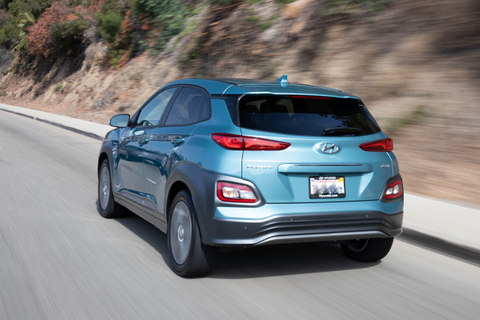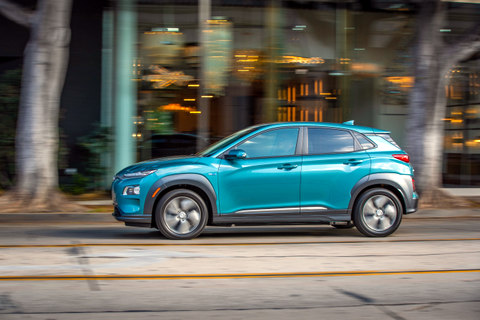Big Battery and Long Range Featured
The compact crossover segment is red hot right now, so why hasn’t there been an all-electric model yet? If you’ve been asking that question, your wait is almost over. The Hyundai Kona, introduced as a gasoline vehicle for 2018, gets a big battery and class-leading range when it arrives in early 2019.
The Chevrolet Bolt EV is the car to beat here, and the Kona EV does it, with a 258-mile EPA range—20 more than the Bolt, thanks to its 64-kWh lithium-ion battery (4 more than the Bolt’s 60 and weighing about the same at nearly 1,000 pounds). The battery pack energy density is 141 Wh/kg, which is greater than the Bolt’s.

The Kona EV’s electric motor puts out 201 horsepower (hp, 150 kW) and 291 pound-feet (lb.-ft.) of torque (vs. 200 hp/266 lb.-ft. for the Bolt respectively).
The EPA’s MPGe estimates are an impressive 132 city mpg/108 highway/120 combined (vs. 128 city/110 highway/119 combined for the Bolt). Hyundai made sure that in every way they are at least slightly ahead of the Bolt, enough for bragging rights.
Fast-Charging Feature
The Kona EV offers standard Level 3 DC fast charging, while it’s an option in the Bolt and Nissan Leaf. It can achieve an 80 percent charge in 54 minutes at 100 kW charging station. Level 2 charging takes 9 hours-35 minutes, essentially equal to the Bolt. The Kona EV’s charger is built into the nose, like the Leaf, while the Bolt’s is on the left front fender.
The Kona itself looks much like other compact crossovers on the market, but in both gas and EV forms does some interesting things with the bumpers and lower body cladding. In the EV, the unnecessary grill is eliminated, as in a Tesla, and a debossed surface keeps it from looking too plain.

The car’s interior delivers the upright, crossover experience folks expect, and the floating center screen they require. A week spent in the gasoline version a few months ago confirms that Hyundai continues to get interiors right these days. We can expect that with an all-electric powertrain, it’ll be nice and quiet inside this EV.
Room to Haul
The Kona EV’s rear cargo holds the same 19.2 cubic feet of cargo as the gasoline model, since the battery is mounted under the floorboard (as in the Bolt). The Bolt’s cargo area holds 16.9 cubic feet.
Cars like the Nissan Leaf, BMW i3, and Chevrolet Bolt are essentially tall hatchbacks, which are efficient, but don’t read as CUVs. The Kona has the cred, with just the right proportions to capture the excitement of this growing segment.
The MSRP isn’t announced yet, but if they price it right, the new 2019 Hyundai Kona EV should enjoy exclusivity for a while, and put more EVs in garages. Distribution will start in California and move on to ZEV-focused states in the hottest EV regions in the U.S West and Northeast regions.
Related Stories You Might Enjoy—Long Range EVs
Comparison Test: 2018 Chevrolet Bolt vs. Nissan Leaf
Road Test: 2017 Chevrolet Bolt
Personal: One Year with My Chevrolet Bolt
Road Test: 2017 BMW i3
Road Trip: 2018 Nissan Leaf
